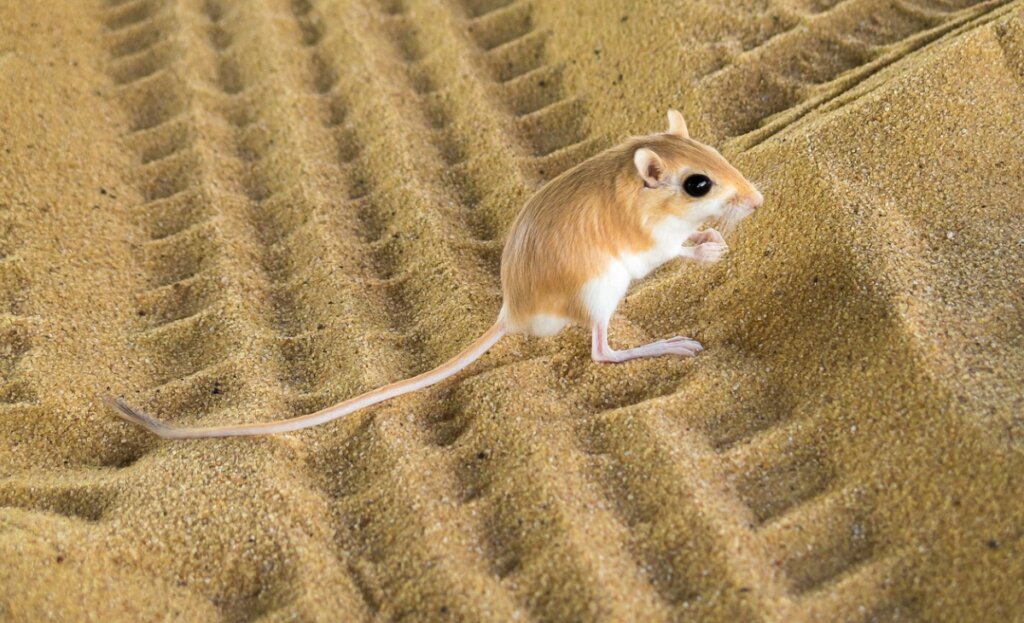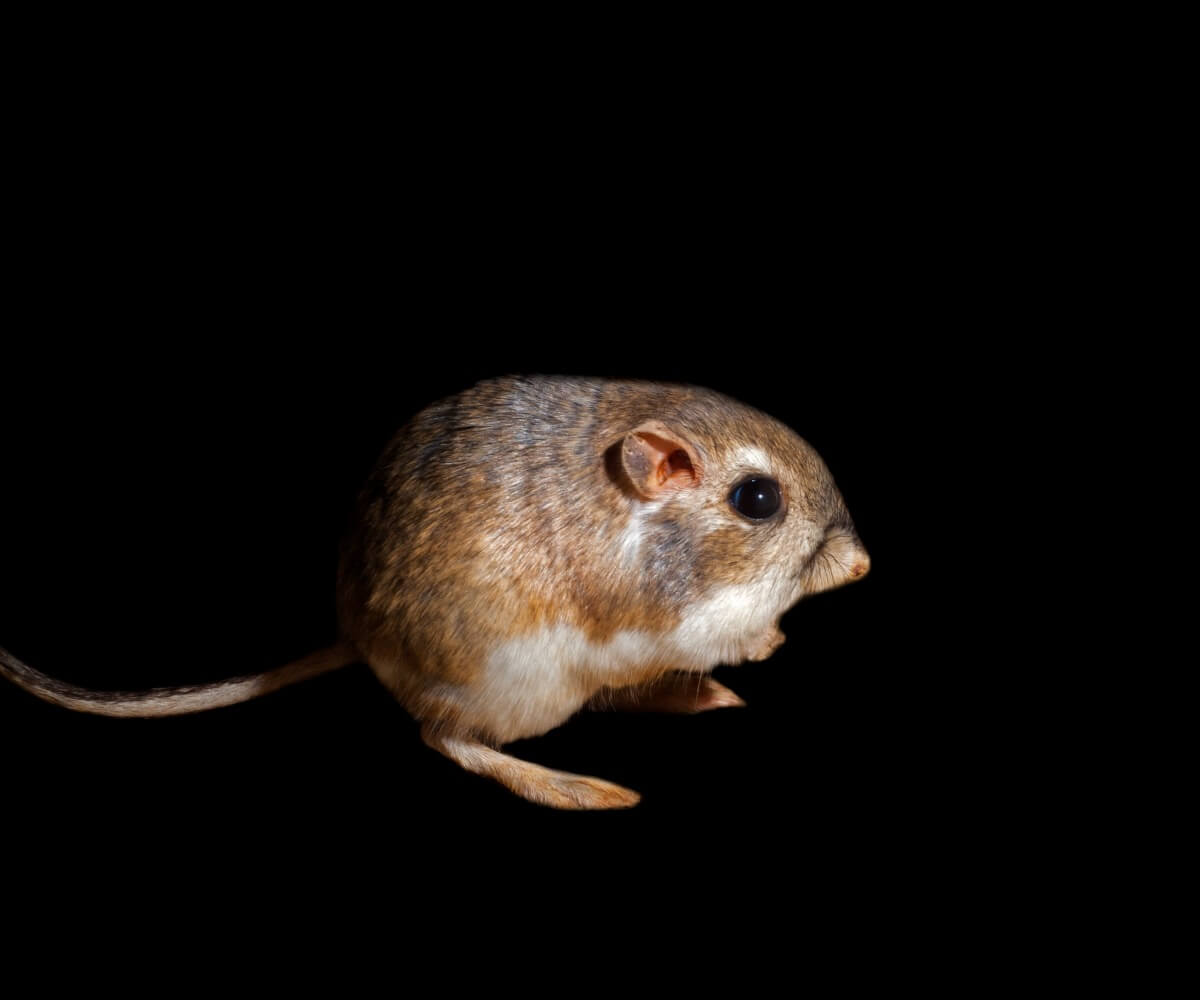Kangaroo Rat: Habitat and Characteristics

The term “kangaroo rat” doesn’t refer to a single species, but to an entire genus of rodents (Dipodomys), a group that includes 22 species of mice native to certain arid areas of North America. Their common name derives from their physiology, as they’re animals that are shown in upright poses on two legs and have a form of movement similar to that of a kangaroo.
These rodents are as friendly as they are interesting on a scientific level. Several investigations have been carried out on their areas of distribution, relationship with other species of the same genus, and their adaptations to the arid environment. If you want to know more about them, keep reading.
Kangaroo rat habitat
Kangaroo rats (genus Dipodomys) are native to North America, inhabiting arid areas, from plains below sea level to rugged areas at 7,100 feet elevation. They belong to the Heteromyidae family, the “other rodents” that can’tt be included with the typical mice that belong to the Muridae family.
The range of distribution depends on the species analyzed. For example, the species Dipodomys agilis is found in southeastern California, while Dipodomys californicus occupies northeastern California and southeastern Oregon. On the other hand, Dipodomys ordii is located from the extreme south of Canada to the center of Mexico.
Interestingly, studies published in the journal Nature have shown that some populations of different species overlap in their range. To avoid competition, they specialize in different niches. For example, Dipodomys ordii prefers grassy soils, while D. merriami selects shrubby areas.
Interspecific competition could have made different species of kangaroo rats adapt to different niches.

Physical characteristics
All rats of the genus Dipodomys have similar characteristics, as they inhabit areas that require very similar adaptations. Kangaroo rats have highly developed hind legs (hence their name), not very prominent forelimbs, a large head, very conspicuous black eyes, and medium-sized ears.
These animals are considered medium-sized rodents, with a range of 35 to 80 grams (1.4 to 3 ounces) in weight and 10 to 20 centimeters (4 to 8 inches) in length. The tail measures the same as the whole body and the coat is dense, soft, and with a silky texture. The tonality varies within each species, but, in general, it goes from a coffee colour to a dark brown, with the belly always remaining whitish.
A very curious way of moving
Kangaroo rats move bipedally, that is, leaning on their hind limbs. As indicated by the Britannica portal, they’re capable of jumping up to 2 meters (6.5 feet) in a single jump, and only use their front legs to travel very small distances. This allows them to reach a speed of 10 kilometers/hour (6 mph) with reduced energy consumption.
Kangaroo rats can also change direction quickly between jumps. This adaptation can save them from coyotes, foxes, snakes, and owls that want to attack them.
Sexual dimorphism
These rats are sexually dimorphic, which means that males and females are externally different. Males are larger than females. However, we should note that size variations can also occur between populations of the same species. Therefore, the distinction with the naked eye is very difficult.
Kangaroo rat diet
Kangaroo rats feed primarily on seeds, although they can also gnaw on vegetables and prey on insects at certain times of the year. In addition, they are able to store food in their cheek pouches, also present in other species of rodents.
For the kangaroo rat, feeding is against the clock. Each specimen must obtain the maximum number of seeds in the shortest possible time. This is because the scorching climate it lives in makes it untenable to stay outside for a long time. For this reason, these rodents jump from one place to another quickly, get more food than they can eat, and take it to their dens.
In addition to this strategy, we should note that kangaroo rats often go out foraging at night, in order to avoid the heat and dehydration. When living in desert environments, activity during the day should be kept to a minimum.
At night there’s less chance of dying from heat exposure, but predators are more active. For this reason, the kangaroo rat rarely leaves its den, day or night.
Other adaptations to life in the desert
As we’ve already mentioned, these rodents spend a large part of their lives in dens or in crevices in the terrain that they make their own. They tend to choose areas of sandy, dry land, with gravel and sparse vegetation to build their shelters, which they spend most of their lives in.
To avoid losing heat and dying of dehydration, these rodents minimize their metabolic rate. Their activity is reduced to the minimum necessary to live. According to studies, some of these species are capable of spending their entire lives without drinking water. The metabolic oxidation of the seeds they eat gives them enough H2O to survive.
Reproduction of the kangaroo rat
These rodents are promiscuous, and they reproduce with as many mates as possible regardless of gender or age. A female will allow several males to mount her in very short periods of time, thus maximizing the chances of producing offspring. Once fertilized, the female gestates her young for a maximum of a month (22-27 days).
In addition, it’s interesting to note that these animals have a reproductive peak during the summer, when the spring rains have passed. This ensures that the offspring will have food to consume and minimizes the mortality rate of the young.
Conservation status of the kangaroo rat
Again, we note that the term “kangaroo rat” encompasses 22 different species, so it isn’t possible to infer a global conservation status. Some species aren’t in any kind of danger (Dipodomys agilis, Dipodomys californicus, Dipodomys compactus and Dipodomys deserti, among others). However, there are others on the verge of disappearing.
Of particular concern is the case of Dipodomys gravipes, listed on the IUCN Red List as “critically endangered”. The reason for this was that, from 1986 to 2017, not a single specimen had been observed. This species has recently been rediscovered, thankfully, but its population status remains deplorable.
Other species of this genus, such as Dipodomys ingens, are also in danger.

As you may have seen, the kangaroo rat is perfectly adapted to the desert environment. Thanks to its low metabolic rate and minimal visits to the outdoors, it’s able to survive on very little water in an environment as harsh as it is fascinating.
All cited sources were thoroughly reviewed by our team to ensure their quality, reliability, currency, and validity. The bibliography of this article was considered reliable and of academic or scientific accuracy.
- Kangaroo rat, Britannica. Recogido a 16 de junio en https://www.britannica.com/animal/kangaroo-rat
- Schroder, G. D., & Rosenzweig, M. L. (1975). Perturbation analysis of competition and overlap in habitat utilization between Dipodomys ordii and Dipodomys merriami. Oecologia, 19(1), 9-28.
- Webster, D. B. (1962). A function of the enlarged middle-ear cavities of the kangaroo rat, Dipodomys. Physiological Zoology, 35(3), 248-255.
- Kaufman, D. W., & Kaufman, G. A. (1982). Effect of moonlight on activity and microhabitat use by Ord’s kangaroo rat (Dipodomys ordii). Journal of Mammalogy, 63(2), 309-312.
- Jones, J. K., & Genoways, H. H. (1975). Dipodomys phillipsii. Mammalian species, (51), 1-3.
